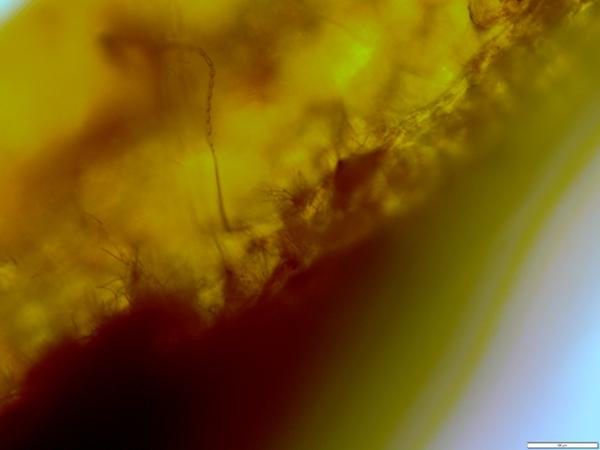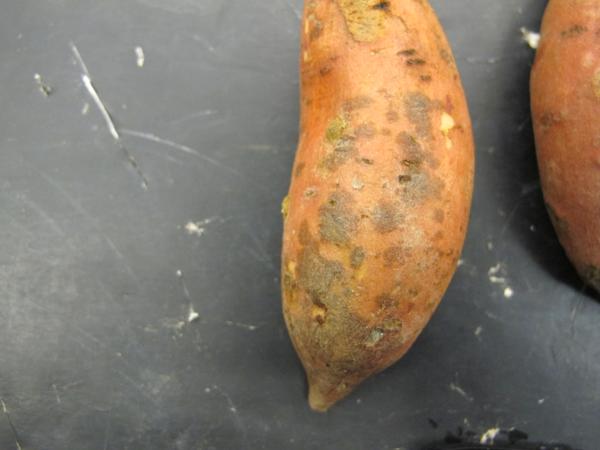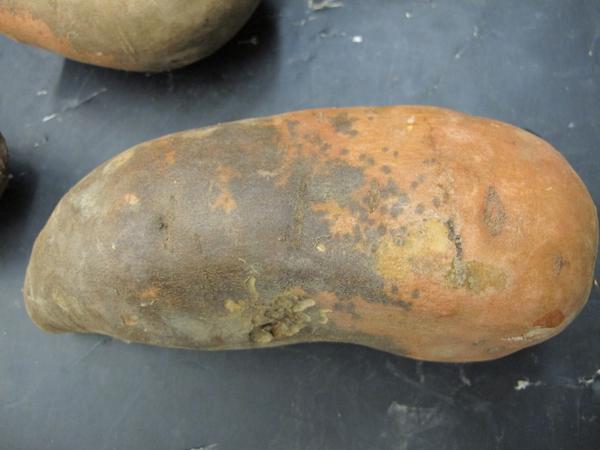Pathogen
Sweetpotato scurf is caused by the ascomycete fungus Monilochaetes infuscans.
Host Crops and Plants
M. infuscans has a very narrow host range, limited only to sweetpotato and it's close relative the morning glory.
Identification
The fungus grows only in the skin of the sweetpotato and produces spores on the surface under high humidity conditions, for example during storage. This pathogen is diagnosed by observation of chains of spores on the surface of the lesions that can be seen only with the aid of a hand lens or microscope (Figure 1 and Figure 2). The diseased areas are purple or grayish-brown to black, are only skin-deep, and enlarge very slowly during storage. Usually, only a few scattered lesions are seen on the root (Figure 3), but in severe cases, almost the entire surface of the root can be affected (Figure 4). In the field, the scurf fungus only attacks underground portions of sweetpotatoes.
Favorable Environmental Conditions for the Disease
Scurf is favored by high humidity and free moisture, and it is usually worse during rainy seasons.
Disease Transmission
The scurf pathogen survives in soil for only 1-3 years, depending on soil type. Survival in soil is higher in fine-textured soils and is also favored by higher organic matter content. The primary means of transmission is through infested soil that comes into direct contact with wounded plant tissue, which typically occurs when slips are pulled instead of cut at least 1 inch above the soil line or when unsanitized tools are used to cut slips.
Another means of spread of the disease is on planting material. The fungus can grow from an infected seed root up onto the sprouts produced from that root. In the field it then can grow from an infected slip down onto the daughter roots produced by that plant.
Healthy roots may become contaminated with fungus spores from diseased roots, and contaminated crates, baskets, and storage houses. During grading operations, spores from diseased roots are dislodged with soil and distributed by air currents, contaminating containers and other sweetpotatoes.
General Disease Management
Prevention is the best method of controlling scurf and several steps can be taken to limit scurf outbreaks.
Set healthy plants:
- Certified seed is the best source of disease-free plants.
- Carefully select seed for bedding. Whether certified seed is used or not, every root should be inspected when selected. Wetting the roots makes scurf spots easier to see.
- Treat the seed before bedding. Unseen contaminating spores can be killed by dipping the roots in a fungicide.
- Use vine cuttings or cut sprouts. Sprouts cut above the soil level, or vine cuttings, of healthy plants will be scurf-free. For fields with history of scurf, the cut sprouts or vines should be dipped to a depth of about 5 inches in a fungicide.
- Do not contaminate plants by placing them in contaminated containers, holding them in contaminated houses, or hauling on contaminated truck bodies. Disinfest contaminated equipment before using.
Use land free of scurf:
- Locate beds in a site known to have been free from sweetpotatoes for three years.
- Plant in scurf-free soils. Rotate sweetpotatoes with other crops to eliminate scurf. In light soils, such as Norfolk sandy loam, a 2- to 3-year rotation is adequate. In heavier soils or those rich in organic matter use a 3- to 4-year rotation.
- Harvest and store sweetpotatoes in clean containers and houses.
- Before harvest, clean and disinfest storage houses, containers, and equipment.
Disease Control for Conventional Growers
No fungicides are effective at controlling this disease after scurf has become established but products can be used to protect seed and slips. The active ingredient dicloran has shown good efficacy for controlling scurf. For the latest fungicide recommendations for sweetpotato scurf see the Southeastern US Vegetable Crop Handbook. Fungicide labels are legal documents, always read and follow fungicide labels.
| Active ingredient | Example product | Fungicide group |
| thiabendazole | Mertect 340-F | 1 |
| dicloran | Botran | 14 |
| fludioxonil | Maxim 4FS | 12 |
| azoxystrobin | Dynasty | 11 |
Useful Resources
- The NC State Plant Disease and Insect Clinic provides diagnostics and control recommendations
- The Extension Plant Pathology Portal provides information on crop disease management
- The Southeastern US Vegetable Crop Handbook provides information on vegetable disease management
- The USDA Fungus-Host Distributions Database provides information about reported hosts for fungal and oomycete pathogens
Acknowledgements
This factsheet was prepared by the NC State Vegetable Pathology Lab in 2013.
Publication date: Dec. 16, 2018
Reviewed/Revised: Jan. 9, 2023
Recommendations for the use of agricultural chemicals are included in this publication as a convenience to the reader. The use of brand names and any mention or listing of commercial products or services in this publication does not imply endorsement by NC State University or N.C. A&T State University nor discrimination against similar products or services not mentioned. Individuals who use agricultural chemicals are responsible for ensuring that the intended use complies with current regulations and conforms to the product label. Be sure to obtain current information about usage regulations and examine a current product label before applying any chemical. For assistance, contact your local N.C. Cooperative Extension county center.
N.C. Cooperative Extension prohibits discrimination and harassment regardless of age, color, disability, family and marital status, gender identity, national origin, political beliefs, race, religion, sex (including pregnancy), sexual orientation and veteran status.




